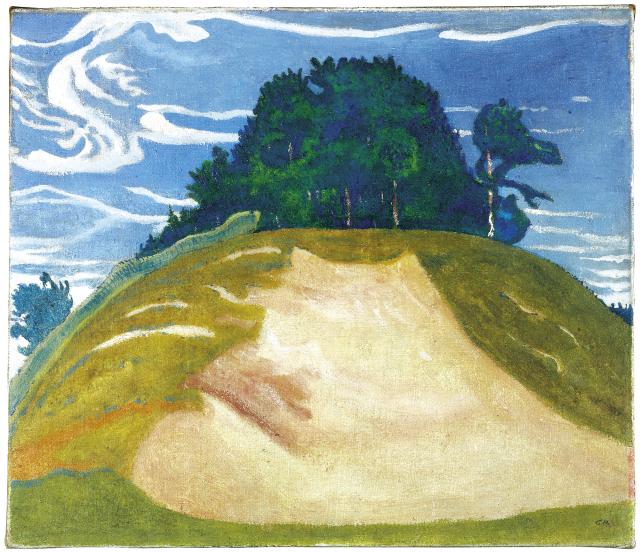In a letter dated 17 February 1894 to his friend Giovanni Giacometti, Cuno Amiet writes, “Nature counts for little in art. I’ll go even further and say that any painting that smacks of the imitation of nature doesn’t have the right to be called a work of art”.
Amiet takes notes before a landscape, then paints from memory, as he learned from the French painters of Pont-Aven. This approach allows him to avoid confining himself to imitation and stimulates his imagination, which has been triggered by observation. In his 1903-1904 canvas Hügel (Hill), the artist’s wise choice of a range of colours matching the canvas’s twisting lines lends both depth and musicality to the work. Like decorative elements, the clouds stretch out in the sky, resonating with the hill. Without ever going as far as abstraction, Amiet often dares to try out innovations in which alone the dosage and organization of the applied colours are enough to carry the painting’s composition.
Also in 1903 he paints Der gelbe Hügel (The Yellow Hill, Kunstmuseum, Solothurn), a variation on the same subject but in a larger format, in which the primary colours blue and yellow set the tone for a hill and its encounter with the sky. The Hügel conserved in the Collection Pictet is all curves and rounded lines as well, although these are done in more naturalist hues. The Pictet Hügel, moreover, reduces the summit’s forest to a grove of trees caught in the celestial winds. All of the canvas’s luminosity emanates from the extraordinary carving out of the hill, while the succeeding colour planes construct through flat uniform areas of pigment the elements of a landscape reinterpreted by Amiet.
“I admire lots of things in Amiet’s work, first of all his eye, which has the ability to perceive and transcribe the colours of nature in a very singular way, as well as his temperament, which is attested to by his forms and the authority of his compositions. I find these qualities especially in the works that serve our discussions with the mother of our artistic infancy, oft-celebrated nature” (Paul Klee).
Amiet takes notes before a landscape, then paints from memory, as he learned from the French painters of Pont-Aven. This approach allows him to avoid confining himself to imitation and stimulates his imagination, which has been triggered by observation. In his 1903-1904 canvas Hügel (Hill), the artist’s wise choice of a range of colours matching the canvas’s twisting lines lends both depth and musicality to the work. Like decorative elements, the clouds stretch out in the sky, resonating with the hill. Without ever going as far as abstraction, Amiet often dares to try out innovations in which alone the dosage and organization of the applied colours are enough to carry the painting’s composition.
Also in 1903 he paints Der gelbe Hügel (The Yellow Hill, Kunstmuseum, Solothurn), a variation on the same subject but in a larger format, in which the primary colours blue and yellow set the tone for a hill and its encounter with the sky. The Hügel conserved in the Collection Pictet is all curves and rounded lines as well, although these are done in more naturalist hues. The Pictet Hügel, moreover, reduces the summit’s forest to a grove of trees caught in the celestial winds. All of the canvas’s luminosity emanates from the extraordinary carving out of the hill, while the succeeding colour planes construct through flat uniform areas of pigment the elements of a landscape reinterpreted by Amiet.
“I admire lots of things in Amiet’s work, first of all his eye, which has the ability to perceive and transcribe the colours of nature in a very singular way, as well as his temperament, which is attested to by his forms and the authority of his compositions. I find these qualities especially in the works that serve our discussions with the mother of our artistic infancy, oft-celebrated nature” (Paul Klee).
